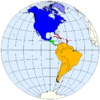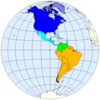Americas
 | |
| Area | 42,549,000 km2 |
|---|---|
| Population | 910,720,588 (July 2008 est.) |
| Population density | 21 km2 (55/sq mi) |
| Demonym | American |
| Countries | 35 |
| Dependencies | 23 List of countries and territories in the Americas |
| Languages | Spanish, English, Portuguese, French, and many others |
| Time zones | UTC-10 to UTC |
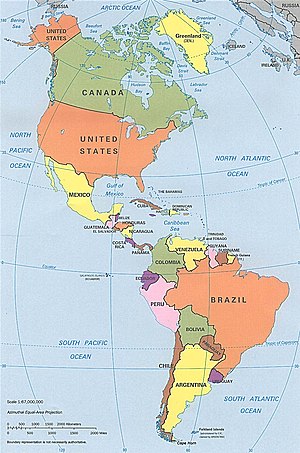
The Americas[1][2] are the lands of the Western hemisphere or New World, comprising the continents of North America and South America with their associated islands and regions. America may be ambiguous in English, as it is more commonly used to refer to the United States of America.[3][2] The Americas cover 8.3% of the Earth's total surface area (28.4% of its land area) and contain about 13.5% of the human population (about 900 million people).
History
Formation
South America broke off from the west of the supercontinent Gondwanaland around 135 million years ago (Ma), forming its own continent.[4] Starting around 15 Ma, the collision of the Caribbean Plate and the Pacific Plate resulted in the emergence of a series of volcanoes along the border that created a number of islands. The gaps in the archipelago of Central America filled in with material eroded off North America and South America, plus new land created by continued volcanism. By 3 Ma, the continents of North America and South America were linked by the Isthmus of Panama, thereby forming the single landmass of the Americas.[5]
Settlement
Humans crossed the Bering land bridge comparatively late in prehistory. Discoveries in Siberia's Altai Mountains have led some anthropologists to theorise that humans were largely prevented from crossing to Alaska due to large numbers of spotted hyenas.[6] Archaeological finds establish the widespread presence of the Clovis culture in North America and South America around 10,000 BCE.[7] Whether this is the first migration of humans into North America and South America is disputed, with alternative theories holding that humans arrived in North America and South America as early as around 40,000 BCE.
| Part of a series on |
| European colonization of the Americas |
|---|
 |
|
|
The Inuit migrated into the Arctic section of North America in another wave of migration, arriving around 1000 CE.[8] Around the same time as the Inuit migrated into North America, Viking settlers began arriving in Greenland in 982 and Vinland shortly thereafter.[9] The Viking settlers quickly abandoned Vinland, and disappeared from Greenland by 1500.[10]
Large-scale European colonization of the Americas began shortly after the voyages of Christopher Columbus starting in 1492. The spread of new diseases brought by Europeans and Africans killed many of the inhabitants of North America and South America,[11][12] with a general population crash of Native Americans occurring in the mid-sixteenth century, often well ahead of European contact.[13] Native peoples and European colonizers came into widespread conflict, resulting in what David Stannard has called a genocide of the indigenous populations.[14] Early European immigrants were often part of state-sponsored attempts to found colonies in the Americas. Migration continued as people moved to the Americas fleeing religious persecution or seeking economic opportunities. Millions of individuals were forcibly transported to the Americas as slaves, prisoners or indentured servants.
Naming
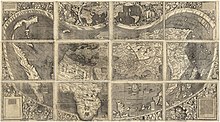
The earliest known use of the name America for this particular landmass dates from April 25, 1507. It appears first on a small globe map with twelve time zones, and then a large wall map created by the German cartographer Martin Waldseemüller in Saint-Dié-des-Vosges in France. An accompanying book, Cosmographiae Introductio, states, "I do not see what right any one would have to object to calling this part, after Americus who discovered it and who is a man of intelligence, Amerige, that is, the Land of Americus, or America: since both Europa and Asia got their names from women". Americus Vespucius is the Latinized version of the Florentine explorer Amerigo Vespucci's name, and America is the feminine form of Americus. [15]. [16] The quote may indicate that the author of this section of the book was here introducing the usage of the personal noun America for this particular purpose in Latin literature.
Vespucci's role in the naming issue, like his exploratory activity, is unclear. Some sources say that he was unaware of the widespread use of his name to refer to the new landmass. Waldseemüller may have been misled by the Soderini Letter, claimed by some to be a forgery, which implies that it was discovered first by Amerigo Vespucci. Christopher Columbus, who had first brought the region's existence to the attention of Renaissance era voyagers, had died in 1506 (believing, to the end, that he had discovered and colonized the Indies he had set out looking for) and could not protest Waldseemüller's decision[17].

An alternate proposal, first advanced by Jules Marcou in 1875 and later recounted by novelist Jan Carew, is that the name America derives from the district of Amerrique in Nicaragua.[18] The gold-rich district of Amerrique was purportedly visited by both Vespucci and Columbus, for whom the name became synonymous with gold. Another theory, first proposed by a Bristol antiquary and naturalist, Alfred Hudd, in 1908 was that America is derived from Richard Amerike (Richard ap Meurig), a Bristol merchant of Welsh descent, who is believed to have financed John Cabot's voyage of discovery from England to Newfoundland in 1497.[19][20][21]
Geography
Extent
The northernmost point of the Americas is Kaffeklubben Island, which is the northernmost point of land on Earth.[22] The southernmost point is the islands of Southern Thule, although they are sometimes considered part of Antarctica.[23] The easternmost point is Nordostrundingen. The westernmost point is Attu Island.
The mainland of the Americas is the longest north-to-south landmass on Earth. At its longest, it stretches roughly 14,000 kilometres, (just under 8700 miles) from the Boothia Peninsula in northern Canada to Cape Froward in Chilean Patagonia. The westernmost point of the mainland of the Americas is the end of the Seward Peninsula in Alaska, while Ponta do Seixas in northeastern Brazil forms the mainland's easternmost extremity.[24]
Topography
The western geography of the Americas is dominated by the American cordillera, with the Andes running along the west coast of South America[25] and the Rocky Mountains and other Western Cordillera ranges running along the western side of North America.[26] The 2300 km long (1429 mile long) Appalachian Mountains run along the east coast of North America from Alabama to Newfoundland.[27] North of the Appalachians, the Arctic Cordillera runs along the eastern coast of Canada.[28]
Between its coastal mountain ranges, North America has vast flat areas. The Interior Plains spread over much of the continent with low relief.[29] The Canadian Shield covers almost 5 million km² of North America and is generally quite flat.[30] Similarly, the north-east of South America is covered by the flat Amazon Basin.[31] The Brazilian Highlands on the east coast are fairly smooth but show some variations in landform, while further south the Gran Chaco and Pampas are broad lowlands.[32]
Hydrology
With coastal mountains and interior plains, the Americas have several large river basins that drain the continents. The largest river basin in South America is that of the Amazon, which has the highest volume flow of any river on Earth.[33] The largest river basin in North America is that of the Mississippi, covering the second largest watershed on the planet.[34] The second largest watershed of South America is that of the Paraná River, which covers about 2.5 million km².[35]
Demography
Population
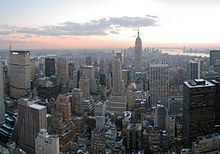

The total population of the Americas is 858,000,000 people per the United Nations' Population and Vital Statistics Report, and is divided as follows:
- North America: 2001 with 495 million and in 2002 with 501 million (includes Central America and Hawaii)
- South America: 2001 with 352 million and in 2002 with 357 million
See also:
Largest Metropolises
The most populated cities in the Americas are Mexico City, capital of Mexico, New York City, located in the east coast of the United States of America, and São Paulo, capital of the Brazilian state of the same name. There is much discussion about which of this Metropolises is the most populated as each one of them can surpass the others based on the criteria of choice.
| City | Country | City Proper Population | Rank | Urban Area Population | Rank | Metropolitan Area Population | Rank |
|---|---|---|---|---|---|---|---|
| Mexico City | 8,841,916 | 2nd | 18,585,000 | 3rd | 20,450,000 | 1st | |
| New York City | 8,363,710 | 3rd | 21,295,000 | 1st | 19,750,000 | 2nd | |
| São Paulo | 11,037,593 | 1st | 19,505,000 | 2nd | 18,850,000 | 3rd |
Ethnology
The population of the Americas is made up of the descendants of seven large ethnic groups and their combinations.
- The Indigenous peoples of the Americas, being Amerindians, Inuit, and Aleuts.
- Those of European ancestry, mainly Spanish, British, Irish, Italian, Portuguese, French, Polish, German, Dutch, and Scandinavian people.
- Mestizos, those of mixed European and Amerindian ancestry.
- Those of Black African ancestry, mainly of West African descent.
- Mulattoes, people of mixed Black African and European ancestry.
- Zambos (Spanish) or Cafusos (Portuguese), those of mixed Black African and Amerindian ancestry.
- Asians, that is, those of Eastern, South, and Southeast Asian ancestry.
- Those from the Middle East (Middle Easterners).
The majority of the population live in Latin America, named for its predominant cultures whose roots lie in Latin Europe (including the two dominant languages, Spanish and Portuguese, both neolatin), more specifically in the Iberian nations of Portugal and Spain (hence the use of the term Ibero-America as a synonym). Latin America is typically contrasted with Anglo-America (where English, a Germanic language, is prevalent) which comprises Canada (with the exception of francophone Canada rooted in Latin Europe (France): see Québec and Acadia) and the United States. Both are located in North America and present predominantly Anglo-Saxon and Germanic roots.
Religion
The most prevalent faiths in the Americas are as follows:
- Christianity (North America: 85 percent; South America: 93 percent)[36]
- Roman Catholicism (practiced by 89 percent of the Mexican population;[37][38] approximately 74 percent of the population of Brazil, whose Roman Catholic population of 182 million is the greatest of any nation's;[39] approximately 24 percent of the United States population;[40] and more than 40 percent of all of Canadians[41])
- Protestantism (practiced mostly in United States, where half of the population are Protestant, and Canada, with slightly more than a quarter of the population; there is a growing contingent of Evangelical and Pentecostal movements in predominantly Catholic Latin America[42])
- Eastern Orthodoxy (found mostly in the United States and Canada— 1 percent of the US citizenry; this Christian group is growing faster than many other Christian groups in Canada and now represents roughly 3 percent of the Canadian population)[citation needed]
- Other Christians and non-denominational Christians (some 1,000 different Christian denominations and sects practiced in the Americas)
- Irreligion (includes atheists and agnostics, as well as those who profess some form of spirituality but do not identify themselves as members of any organized religion)
- Islam (practiced by 2 percent of Canadians (580,000 persons)[43], 0.6% to 2% percent of the U.S. population (1,820,000 persons[40] to 5,000,000+[44]), and 0.2% of Mexicans (250,000 persons)[45]. Together, Muslims constitute over 2.5% of the North American population. North American cities with high concentrations of Muslims include Toronto, Los Angeles, New York City, Detroit, Houston, Chicago, Philadelphia, Washington, D.C., and etc; 0.3 percent of all Latin Americans-Argentina has the largest Muslim communities in Latin America with up to 600,000 persons or 1.9% of the population.[46])
- Judaism (practiced by 2 percent of North Americans—approximately 2.5 percent of the U.S. population and 1.2 percent of Canadians[47]; 0.23 percent of Latin Americans—Argentina also has the largest Jewish communities in Latin America with 200,000 members.[48])
Other faiths include Sikhism; Buddhism; Hinduism; Bahá'í; a wide variety of indigenous religions, many of which can be categorized as animistic; and many African and afro-derived religions. Syncretic faiths can also be found throughout the continent.
Languages

Various languages are spoken in the Americas. Some are of European origin, others are spoken by indigenous peoples or are the mixture of various idioms like the different creoles.
The dominant language of Latin America is Spanish, though the largest nation in Latin America, Brazil, speaks Portuguese. Small enclaves of French- and English-speaking regions also exist in Latin America, notably in French Guiana and Belize respectively, and Haitian Creole, of French origin, is dominant in the nation of Haiti. Native languages are more prominent in Latin America than in Anglo-America, with Nahuatl, Quechua, Aymara and Guaraní as the most common. Various other native languages are spoken with less frequency across both Anglo-America and Latin America. Creole languages other than Haitian Creole are also spoken in parts of Latin America.
The dominant language of Anglo-America, as the name suggests, is English. French is also official in Canada, where it is the predominant language in Québec and an official language in New Brunswick along with English. It is also an important language in the U.S. state of Louisiana. Spanish has kept an ongoing presence in the Southwestern United States, which formed part of the Viceroyalty of New Spain, especially in California and New Mexico, where a distinct variety of Spanish spoken since the 17th century has survived. It has more recently become widely spoken in other parts of the United States due to heavy immigration from Latin America. High levels of immigration in general have brought great linguistic diversity to Anglo-America, with over 300 languages known to be spoken in the United States alone, but most languages are spoken only in small enclaves and by relatively small immigrant groups.
The nations of Guyana, Suriname, and Belize are generally considered not to fall into either Anglo-America or Latin America due to lingual differences with Latin America, geographic differences with Anglo-America, and cultural and historical differences with both regions; English is the primary language of Guyana and Belize, and Dutch is the official and written language of Suriname.
- Spanish – spoken by approximately 310 million in many nations throughout the continent.
- English – spoken by approximately 300 million people in the United States, Canada, Jamaica, Trinidad and Tobago, The Bahamas, Bermuda, Belize, Guyana, the Falklands and many islands of the Caribbean.
- Portuguese – spoken by approximately 185 million in South America, mostly Brazil [49]
- French – spoken by approximately 12 million in Canada (majority 7 million in Québec—see also Québec French), and Acadian communities in New Brunswick and Nova Scotia); the Caribbean (Haiti, Guadeloupe, Martinique); French Guiana; the French islands of Saint Pierre and Miquelon; and Acadiana (a Francophone area in southern Louisiana, United States).
- Quechua – native language spoken by 10–13 million speakers in Ecuador, Peru, Bolivia, northern Chile, and northwest Argentina.[50]
- Haitian Creole – creole language, based in French and various African languages, spoken by 6 million in Haiti and the Haitian Diaspora in Canada and the United States.[51]
- Guaraní (avañe'ẽ) – native language spoken by approximately 6 million people in Paraguay, and regions of Argentina, Bolivia, and Brazil.
- Chinese languages are spoken by at least 5 million people living mostly in the United States, Canada, Peru and Panama.
- Italian – spoken by approximately 4 million people, mostly New England / Mid-Atlantic in the United States, southern Ontario and Quebec in Canada, Argentina, Uruguay and Brazil, and also includes pidgin dialects of Italian such as Talian (Brazil), and Chipilo (Mexico).
- German – Some 2.2 million. Spoken by 1.1 million people in the United States plus another million in parts of Latin America, such as Brazil, Argentina, Chile, and Paraguay.
- Aymara – native language spoken by about 2.2 million speakers in the Andes, in Bolivia, Peru and Chile.[52][53]
- Quiché and other Maya languages – native languages spoken by about 1.9 million speakers in Guatemala and southern Mexico.
- Nahuatl – native language of central Mexico with 1.5 million speakers. Also was the language of the Aztec People of Mexico.
- Antillean Creole – spoken by approximately 1.2 million in the Eastern Caribbean (Guadeloupe, Martinique, Dominica, Saint Lucia) and French Guiana.
- Javanese is a major language in Suriname
- Tagalog has been present in the continent since the Spanish empire. It is now spoken by 1.5 million people mostly living in the United States and Canada.
- Vietnamese is spoken by 1 million recent immigrants to the United States.
- Various Indian languages such as Hindi and Punjabi are spoken by Indo-Caribbeans and have large populations in the United States and Canada.
- Korean has recently become a major language in the United States with about 1 million speakers.
- Japanese was once a major minority language in the United States but has recently dwindled in terms of population. Also found in Brazil and Peru.
- Hmong is an indigenous language in Southeast Asia, whose largest number of speakers outside Asia is in the United States
- American Sign Language – An estimated 100,000–500,000 people within the Deaf Community use ASL as their primary language in the United States and Canada.[54]
- Mapudungun (or Mapuche) – native language spoken by approximately 440,000 people in Chile and Argentina.
- Navajo – native language spoken by about 178,000 speakers in the Southwest U.S. on the Navajo Nation (Indian reservation).[55] The tribe's isolation until the early 1900s provided a language used in a military code in World War II.
- Dutch – spoken in the Netherlands Antilles, Aruba, and Suriname by about 210,000 speakers.
- Miskito – Spoken by up over 180,000 Miskitos. They are Indigenous people who inhabit the Caribbean coast of Nicaragua and the easternmost region of Honduras.
- Pennsylvania Dutch – Some descendants of the Pennsylvania Dutch in the Northeast U.S. speak a local form of the German language which dates back to the seventeenth and eighteenth centuries. They number about 85,000.
- Inuit – native language spoken by about 75,000 across the North American Arctic and to some extent in the subarctic in Labrador.
- Danish – and Greenlandic (Inuit) are the official languages of Greenland; most of the population speak both of the languages (approximately 50,000 people). A minority of Danish migrants with no Inuit ancestry speak Danish as their first, or only, language.
- Cree – Cree is the name for a group of closely-related Algonquian languages spoken by approximately 50,000 speakers across Canada.
- Nicaraguan Creole – Spoken in Nicaragua by up to 30,000 people. It is spoken primarily by persons of African, Amerindian, and European descent on the Caribbean Coast.
- Garífuna (or Garinagu) - native language spoken by the Garífuna people who inhabits parts of the caribbean coast of Belize, Guatemala, Honduras and Nicaragua. The vast majority of them live in Honduras.
- Welsh – In Argentina, two towns of Trelew and Rawson were settled by Welsh immigrants in the late nineteenth century and the Welsh language remains spoken by about 25,000, including the towns' older residents.
- Cherokee – native language spoken in a small corner of Oklahoma, U.S. by about 19,000 speakers. The use of this language has rebounded in the late twentieth century. It is known to possess its own alphabet, the Cherokee syllabary.
- Gullah – a creole language based on English with strong influences from West and Central African languages spoken by the Gullah people, an African American population living on the coastal region of the U.S. states of South Carolina and Georgia.
- Sranan Tongo, also known as Taki Taki, is the most used spoken language of Suriname. It is not usually used in its written form. It is a creole language based on Spanish, English, Dutch, Hindustani, and various other languages.
Most of the non-native languages have, to different degrees, evolved differently from the mother country, but are usually still mutually intelligible. Some have combined, however, which has even resulted in completely new languages, such as Papiamentu, which is a combination of Portuguese, Spanish, Dutch (representing the respective colonizers), native Arawak, various African languages, and, more recently, English. Because of immigration, there are many communities where other languages are spoken from all parts of the world, especially in the United States, Brazil, Argentina, and Canada, four very important destinations for immigrants.

Terminology

America/Americas
In many parts of the world, America in the singular is commonly used as a name for the United States of America; however, (the) Americas (plural with s and generally with the definite article) invariably refers to the lands and regions of the Western hemisphere. Usage of America to also refer to this collectivity remains fairly common;[56] for example, the International Olympic Committee reckons America as one of the five inhabited continents, which is depicted in the Olympic logo.[57]
While many in the United States of America and other countries generally refer to the country as America and US residents/citizens as Americans,[58] many people elsewhere in the Americas resent what they perceive as misappropriation[59] of the term in this context and, thus, this usage is frequently avoided.[60][61][62] In Canada, their southern neighbor is seldom referred to as "America", with the United States, the U.S., or (informally) the States used instead.[61] English dictionaries and compendiums differ regarding usage and rendition.[63][64][65]
American
English usage
Whether usage of America or the Americas is preferred, American is a self-referential term for many people living in the Americas. However, much of the English-speaking world uses the word to refer solely to a citizen, resident, or national of the United States of America. Instead, the word pan-American is sometimes used as an unambiguous adjective to refer to the Americas.
In addition, many Canadians resent being referred to as Americans because of mistaken assumptions that they are U.S. citizens or an inability—particularly of people overseas—to distinguish Canadian English and American English accents.[61]
Spanish usage
In Spanish, América is the name of a region considered a single continent composed of the subcontinents of Sudamérica and Norteamérica, the land bridge of Centroamérica, and the islands of the Antillas. Americano/a in Spanish refers to a person from América in a similar way that europeo or europea refers to a person from Europa. The terms sudamericano/a, centroamericano/a, antillano/a and norteamericano/a can be used to more specifically refer to the location where a person may live.
Citizens of the United States of America are normally referred to by the term estadounidense (rough literal translation: "United-Statesian") instead of americano or americana, and the country's name itself is often translated as Estados Unidos de Norteamérica. Also, the term norteamericano may refer to a citizen of the United States. This term is primarily used to refer to citizens of the United States, rarely those of other North American countries.[66]
Portuguese usage
In Portuguese, the word americano refers to the whole of the Americas. But, in Brazil and Portugal, it is widely used to refer to the citizens of the United States. The least ambiguous term, estadunidense (used in Brazil), something like "United Statian" or "estadounidense" in Spanish language), and "ianque"—the Portuguese version of "Yankee"—are rarely used. América, however, is rarely used as synonym to the country, and almost never in print and in more formal environments, where the US is called either Estados Unidos da América (i.e. United States of America) or simply Estados Unidos (i.e. United States). There is some difference between the usage of these words in Portugal and in Brazil, with the Portuguese being more prone to apply the term América to the country.
French usage
In French, as in English, the word Américain can be confusing as it can be used to refer either to the United States, or to the American continents.
The noun Amérique sometimes refers to the whole as one continent, and sometimes two continents, southern and northern; the United States is generally referred to as les États-Unis d'Amérique, les États-Unis, or les USA. However, the usage of Amérique to refer to the United States, while technically not correct, does still have some currency in France.
The adjective américain is most often used for things relating to the United States; however, it may also be used for things relating to the American continents. Books by United States authors translated from English are often described as "traduit de l'américain".
Things relating to the United States can be referred to without ambiguity by the words états-unien, étasunien, or étatsunien, although their usage is rare.
Dutch usage
In Dutch, the word Amerika mostly refers to the United States. Although the United States is equally often referred to as de Verenigde Staten or de VS, Amerika relatively rarely refers to the Americas, but it is the only commonly used Dutch word for the Americas. This often leads to ambiguity and to stress that something concerns the Americas as a whole, Dutch uses a combination, namely Noord- en Zuid Amerika (North and South America).
Latin America is generally referred to as Latijns Amerika or, less frequently, Zuid Amerika (South America).
The adjective amerikaans is most often used for things or people relating to the United States. There are no alternative words to distinguish between things relating to the United States or to the Americas. Dutch uses the local alternative for things relating to elsewhere in the Americas, such as Argentijns for Argentinian etc.
Russian usage
In the 19th century in Russia the word "America" was used for a traditional continent such as Europe and Asia. In the 20th century these traditional continents are known as "parts of the world". Now the term "continent" means any of six large continuous landmasses (Eurasia, Africa, North America, South America, Antarctica, and Australia). Now the word Ameriсa refers to the United States more often than to America as a "part of the world". There is no term equivalent to "Americas" in Russian.
Countries and territories
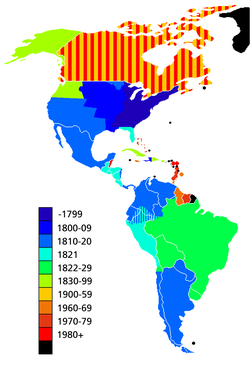
Sovereign states
There are 35 sovereign states in the Americas, 23 in North America and 12 in South America:
Overseas regions, dependencies, colonies
The following is a list of places in the Americas that do not fall into the category "Sovereign states", grouped by the nations that control them.
|
|
|
Multinational organizations in the Americas
See also
Footnotes
- ^ america - Definition from the Merriam-Webster Online Dictionary. Retrieved on January 27, 2008.
- ^ a b america. Dictionary.com. The American Heritage Dictionary of the English Language, Fourth Edition. Houghton Mifflin Company, 2004. http://dictionary.reference.com/browse/america (accessed: January 27, 2008).
- ^ "America." The Oxford Companion to the English Language (ISBN 0-19-214183-X). McArthur, Tom, ed., 1992. New York: Oxford University Press, p. 33: "[16c: from the feminine of Americus, the Latinized first name of the explorer Amerigo Vespucci (1454-1512). A claim is also made for the name of Richard Ameryk, sheriff of Bristol and patron of John Cabot (Giovanni Caboto), the 16c Anglo-Italian explorer of North America. The name America first appeared on a map in 1507 by the German cartographer Martin Waldseemüller, referring to the area now called Brazil]. Since the 16c, a name of the western hemisphere, often in the plural Americas and more or less synonymous with the New World. Since the 18c, a name of the United States of America. The second sense is now primary in English: ... However, the term is open to uncertainties: ..."
- ^ Brian C. Story (28 September 1995). "The role of mantle plumes in continental breakup: case histories from Gondwanaland". Nature. 377: 301–309. doi:10.1038/377301a0.
- ^ "Land bridge: How did the formation of a sliver of land result in major changes in biodiversity". Public Broadcasting Corporation.
- ^ Scientist: Hyenas May Have Hunted People. Oversized Hyenas May Have Delayed Human Arrival in North America
- ^ David S. Whitley and Ronald I. Dorn (1993). "New Perspectives on the Clovis versus Pre-Clovis Controversy" ([dead link] – Scholar search). American Antiquity: 626–647.
{{cite journal}}: External link in|format= - ^ "Canadian Inuit History". Canadian Museum of Civilization.
- ^ "Vinland". Canadian Museum of Civilization.
- ^ "The Norse settlers in Greenland - A short history". Greenland Guide - The Official Travel Index.
- ^ Russell Thornton (1997). "Aboriginal North American Population and Rates of Decline, c.a. A.D. 1500–1900" ([dead link] – Scholar search). Current Anthropology. 38 (2): 310–315. doi:10.1086/204615.
{{cite journal}}: External link in|format= - ^ Alfred W. Crosby (April 1976). "Virgin Soil Epidemics as a Factor in the Aboriginal Depopulation in America". David and Mary Quarterly. 33 (2): 289–299.
- ^ Henry F. Dobyns (1993). "Disease Transfer at Contact". Annual Review of Anthropology. 22 (22): 273–291. doi:10.1146/annurev.an.22.100193.001421.
- ^ Staff. A review of American Holocaust: The Conquest of the New World (by David Stannard), on the website of the Oxford University Press (the publishers)
- ^ Cartographer put 'America' on the map 500 years ago - USATODAY.com
- ^ [1]
- ^ http://news.bbc.co.uk/1/hi/magazine/8328878.stm
- ^ George C. Hurlbut (1888). "The Origin of the Name "America"". Journal of the American Geographical Society of New York. 20: 183–196. doi:10.2307/196759.
- ^ "BBC History - The Naming of America". BBC History website. BBC. 2001-10-01. Retrieved 2008-11-26.
- ^ "Davies. Wales and America, John Davies, [[University of Wales]], [[Aberystwyth]]" (PDF). North American Journal of Welsh Studies Volume 1, Number 1-2 (Winter-Summer 2001). North American Journal of Welsh Studies, Vol. 1, 1. 2001. Retrieved 2008-11-26.
{{cite web}}: Text "PDF" ignored (help); Text "p.12" ignored (help); URL–wikilink conflict (help) - ^ "The Xenophobe's Guide to the Welsh - Google Book Search". Google Book Search website. Oval Projects Ltd. 1999. p. 21. Retrieved 2008-11-26.
- ^ Charles Burress (June 17, 2004). "Romancing the north Berkeley explorer may have stepped on ancient Thule". San Francisco Chronicle.
- ^ "South Georgia and the South Sandwich Islands, Antarctica - Travel".
- ^ "America". The World Book Encyclopedia. Vol. 1. World Book, Inc. 2006. p. 407. ISBN 0716601060.
- ^ "Andes Mountain Range".
- ^ "Rocky Mountains".
- ^ "Appalachian Mountains". Ohio History Central.
- ^ "Arctic Cordillera".
- ^ "Interior Plains Region".
- ^ "Natural History of Quebec".
- ^ "Strategy". Amazon Conservation Association.
- ^ "South America images".
- ^ "Greatest Places: Notes: Amazonia".
- ^ "Mississippi River".
- ^ "Great Rivers Partnership - Paraguay-Parana".
- ^ CBC Montreal - Religion
- ^ "Mexico - MSN Encarta Encyclopedia - Mexico". Archived from the original on 2009-10-31.
{{cite web}}: Unknown parameter|deadurl=ignored (|url-status=suggested) (help) - ^ "Religión" (PDF). Censo Nacional de Población y Vivienda 2000. INEGI. 2000. Retrieved 2009-01-19.
- ^ International Religious Freedom Report, U.S. Department of State. Retrieved on 2008-06-08.
- ^ a b CIA - The World Factbook - United States
- ^ The Daily, Tuesday, May 13, 2003. Census of Population: Income of individuals, families and households; religion
- ^ The World Today - Catholics faced with rise in Protestantism
- ^ Population by religion, by province and territory (2001 Census)
- ^ Understanding Islam by Susan Headden of U.S. News & World Report. April 7, 2008.
- ^ Islam and Christianity: Islam in Mexico
- ^ "Argentina". International Religious Freedom Report. U.S. Department of State. 2006. Retrieved 2009-09-01.
- ^ Canadian Jewry Today: Portrait of a Community in the Process of Change - Ira Robinson
- ^ First Planeload of Jews Fleeing Argentina Arrives in Israel
- ^ "Portuguese Facts".
- ^ "Now Bolivia Can Do Windows".
- ^ Bambi B. Schieffelin; Rachelle Charlier Doucet (February 1994). "The "Real" Haitian Creole: Ideology, Metalinguistics, and Orthographic Choice". American Ethnologist. 21 (1): 176–200. doi:10.1525/ae.1994.21.1.02a00090.
{{cite journal}}: CS1 maint: multiple names: authors list (link) - ^ Chile National Census 2002, figures cited in Bilingüismo y el registro matemático aymara
- ^ Chile profile, Ethnologue, retrieved October 10th, 2007
- ^ Mike Gasser. "A3 Languages cited in this book".
- ^ "American Indian & Alaska Native Heritage Month: November 2003". United States' Census Bureau.
- ^ Reader's Digest Oxford Complete Wordfinder. 1993. (ISBN 0-27-642101-9) New York, USA: Reader's Digest Association; p. 45.
- ^ The Olympic symbols. International Olympic Committee. 2002. Lausanne: Olympic Museum and Studies Centre. The five rings of the Olympic flag represent the five inhabited, participating continents (Africa, America, Asia, Europe, and Oceania).
- ^ Burchfield, R. W. 2004. Fowler's Modern English Usage. (ISBN 0-19-861021-1) Oxford, UK: Oxford University Press; p. 48.
- ^ "Uso abusivo", numeral 4 http://buscon.rae.es/dpdI/SrvltGUIBusDPD?lema=Estados%20Unidos
- ^ "American." The Oxford Companion to the English Language (ISBN 0-19-214183-X); McArthur, Tom, ed., 1992. New York: Oxford University Press, p. 35.
- ^ a b c "America." Oxford Guide to Canadian English Usage. (ISBN 0-19-541619-8) Fee, Margery and McAlpine, J., ed., 1997. Toronto: Oxford University Press; p. 36.
- ^ "America." Microsoft Encarta Dictionary. 2007. Microsoft. Archived 2009-10-31.
- ^ America - Definition from the Merriam-Webster Online Dictionary
- ^ America - Definitions from Dictionary.com
- ^ [2]
- ^ Diccionario Panhispánico de Dudas:Norteamérica
References
- "Americas". The Columbia Gazetteer of the World Online. 2006. New York: Columbia University Press.
- "Americas". Encyclopædia Britannica, 15th ed. 1986. (ISBN 0-85229-434-4) Chicago: Encyclopædia Britannica, Inc.
- Burchfield, R. W. 2004. Fowler's Modern English Usage. (ISBN 0-19-861021-1) Oxford, UK: Oxford University Press.
- Fee, Margery and McAlpine, J. 1997. Oxford Guide to Canadian English Usage. (ISBN 0-19-541619-8) Toronto: Oxford University Press.
- Kane, Katie Nits Make Lice: Drogheda, Sand Creek, and the Poetics of Colonial Extermination Cultural Critique, No. 42 (Spring, 1999), pp. 81–103 doi:10.2307/1354592
- Pearsall, Judy and Trumble, Bill., ed. 2002. Oxford English Reference Dictionary, 2nd ed. (rev.) (ISBN 0-19-860652-4) Oxford, UK: Oxford University Press.
- Churchill, Ward A Little Matter of Genocide 1997 City Lights Books ISBN 0872863239
- What's the difference between North, Latin, Central, Middle, South, Spanish and Anglo America? Geography at about.com.


